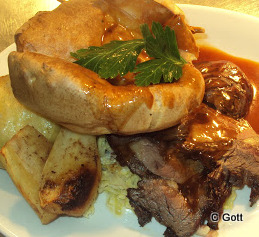As the time for long, lazy, Sunday lunch barbecues in the garden looks to be coming to an end, for this year at least, I thought I would publish a couple of recipes to polish up your classic roast to chef like standards. What can be more symbolic of Sunday lunch than the Yorkshire Pudding, the traditional accompaniment alongside roast potatoes, parsnips and spicy, hot English mustard to a hunk of rare roast beef. You can find this most English of dishes cooked around the world, where ever a few expatriates gather together, but I am always surprised to find Yorkshire Puddings, albeit under another name, over in the USA.
Let’s call Yorkshire pudding
A fortunate blunder:
It’s a sort of popover
That turned and popped under.
Ogden Nash
Of the Yorkshire pudding it has been said, it can only successfully be made by someone from that most august county of England. Grand, my mum is from Yorkshire and makes wonderful Yorkies and perhaps the skill is inherited because I am pretty proud of most of my attempts. A Yorkshire Pudding is made from a milk, egg and flour batter, which was originally poured into a tin set under the roasting joint. The pudding cooked in the hot meat fat and absorbed any juices from the roast. A large slice was served to each dinner with meat gravy before the main course. The meat and vegetables then followed, usually served with a parsley or white onion sauce.
In 1747 in ‘ The Art of Cookery made Plain and Easy ‘ by Hannah Glasse, one of the first English, famous female cookery writers, there is a recipe for Yorkshire pudding. This is the first time a batter or dripping pudding is recorded with the name, although a flatter less aerated dish had been cooked for many years previously. Traditionally any left over pudding could be eaten as a dessert with sugar and perhaps orange juice.
The Yorkshire pudding recipe popped over to America ( excuse the pun ) and the first recipe for a Popover is recorded in ‘ Practical Cooking ‘ published in 1876 by M. N. Henderson. Popovers may be served either as a sweet, topped with fruit and whipped cream for breakfast or with afternoon tea, and with roasted meats at lunch and dinner. Popovers tend to be individually baked in muffin tins and often include herbs or garlic in the recipe. Another popular variation replaced some of the flour in the batter mix with pumpkin purée. The name Popover is thought to come from the fact that the cooked batter swells or pops over the top of the baking tin.
In 2008 the Royal Society of Chemistry held a competition, carried out to create a vouch safe Yorkshire Pudding recipe and somewhat arbitrarily decided that a true Yorkshire Pudding cannot be less than four inches tall. They examined the effects of temperature, ingredients and even altitude in the search for perfection. My knowledge of chemistry is limited to an ancient ‘ O ‘ level but quite simply the heat causes the two raising agents, the egg and beaten in air, to expand the batter mix. My tips for success are simple are make sure all the ingredients are at room temperature and get the fat in your baking tray smoking hot. There I have shared the secret and that is because as they say in Yorkshire ‘ I’m a reight gud sooart ‘.
Individual Yorkshire puddings can be cooked after your joint while it is resting before carving.
Perfect Yorkshire Puddings
90 gr Plain Flour
1 fresh Egg
Around 250 ml half full fat Milk / half Water
¼ teaspoon Salt
A good pinch of freshly ground White Pepper.
1-2 tablespoon of good Beef Dripping.
Preheat your oven to 220C/425F/Gas mark 7. Place a damp cloth on your work surface to stop your mixing bowl slipping and place the bowl on top. Sieve the flour, pepper and salt into your bowl, make a well in the middle and add the egg. Start to beat together then gradually add the milk / water. Continue adding the milk/ water until the batter is smooth and the consistency of pouring cream. Leave the mixture to stand for ten minutes. While the mixture stands, divide the beef dripping into Yorkshire Pudding tins and place the tins in the oven until the fat starts to smoke. Give the batter a final stir and pour quickly into the tins. Put them back in the oven and cook until well risen and golden brown, this will take about fifteen to twenty five minutes depending on the size of your tin.
For the full Royal Society of Chemistry press release

